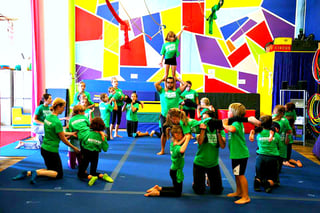 It’s challenging enough to run a class-based business targeted towards adults. But when you cater to adults and kids (or even if you only serve kids) it can feel like you’re running two businesses at once: one for the kids and one for their parents.
It’s challenging enough to run a class-based business targeted towards adults. But when you cater to adults and kids (or even if you only serve kids) it can feel like you’re running two businesses at once: one for the kids and one for their parents.
Many business owners that try to expand to kids’ programming go about it the wrong way. They take their adult programs and try to make them fit for a younger audience. This often leads to failure. Even though they often seem like mini-adults, kids are, well, kids. They have unique needs that your business will need to meet to be successful.
If you run a business that caters to kids, or are thinking about expanding into it, keep these six things in mind.
1. Hire the right staff
Don’t jump into kids programming without first considering all of the logistics. Who is going to lead the new kids’ classes? You? You’re already busy managing the whole business. A parent? They may not necessarily be a good coach.
If you want to start serving kids, hire someone who can make sure the program is done right. Otherwise your kids’ classes will always feel like a weight on your already established adult programming. The right hire will be able to inspire kids and get them excited about the classes. And when kids are happy, their parents are happy. That’s the right recipe for client retention.
2. Offer programming fit for a kid
Kids are not just small adults. They have different motivations and needs than adults do, and any program not specifically built for them has a good chance of failing. Kids want to have fun, and most of them aren’t going to be the star talent. Your kids programs should aim to engage without pushing too hard. If it’s too hard or no fun, the kids won’t want to come back.
The good news is, if you’ve chosen the right person to lead the program this will likely take care of itself.

3. Make sure the price is right
Many business owners base the pricing for their kids’ programming off of their adult class pricing. This is the wrong way to go about it. Kids are their own marketplace. Instead of basing prices off of adult classes you already have, do some competitive analysis to see what similar businesses are charging. That way you can adjust to be competitive in the market.
Note: it’s ok to offer special pricing to the children of your adult clients.
4. Market like you’re a new business
Maybe you really are a new business. But even if your business for adults has been well-established for twenty years you’ll want to market your kids’ programming as if it’s brand new. Take all of the things you did to market your original business–your website, social media, flyers, word-of-mouth, etc.–and apply those same methods to your kids’ programs.
Remember that you’re now going after a new market and don’t let yourself skip these steps. It’s dangerous to assume that your kids’ business will flourish just because your adult business does.
5. Don’t forget about their parents
Parents of your young clients will need different assurances than the kids will. While kids are wholly focused on how fun the program is, parents might be more interested in how safe it is. Don’t just appeal to parents with a competitive price–they need to trust that their child will be well taken care of at your business.
Parents are also a target for your marketing efforts. While a kid may see a flyer and be interested in a class, it’s also possible (and depending on the kid’s age, likely) that a parent will initiate the first visit. Think about who these parents are–involved in their kids’ lives and seeking out enrichment activities for them–and market your business to them.
6. Have the right tools in place
Administration becomes a lot more complicated when dependents (kids) are involved. Is the system you use to manage your adult clients flexible enough to handle kids, too?
Parents need to be able to manage schedules and profiles for their dependents, whether it’s one child or multiple. That means they’ll need access to your system even if they aren’t a client themselves. If the parent is a client of yours, that means your software will need to be able to organize multiple accounts within families.
And there’s a lot more to think of than just that. The software will need to be able to keep schedules organized within families, accurately attribute billing to the correct profiles, break out reporting by family member...did I mention it’s like running a whole other business?
Running a kids business is tough, but don’t let it intimidate you. With the right tools and the right plan, you’ll be setting yourself up for success.